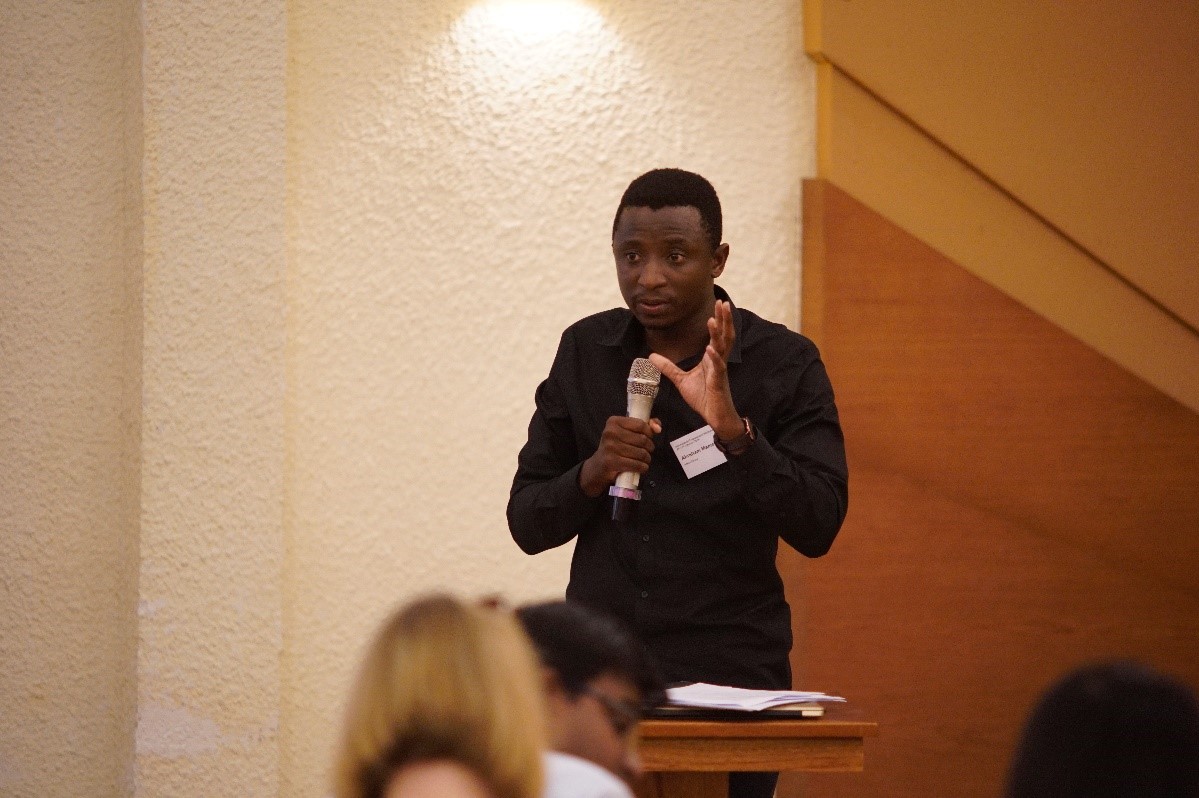
Image: Abraham presenting at the 2018 Wellcome International Engagement Workshop | Minh Tan
At the 2018 Wellcome International Engagement Workshop, Abraham Mamela, a Wellcome public engagement fellow and science engagement professional based in Botswana, presented on making engagement projects sustainable. Having just started his fellowship, Abraham told attendees about his ideas for developing the capacity of the field; he focused on how to build ecosystems and networks which will facilitate and nurture good engagement.
He posed a series of questions: How can we develop the capacity of communities to sustain projects? What relationships and resources could be put in place to support projects into the future? How can we build partnerships that co-own the proposal? How do other industries do this, and how can we work with others to raise the quality and improve the sustainability of projects? Abraham’s answer to many of these questions lies within the creation of a ‘project ecosystem’, where different projects can be nurtured and developed at different points throughout their existence by actors with relevant skills and resources.
The way projects are currently managed in the engagement space are like planes in the sky - according to Abraham – as they progress they leave behind trails which might intersect with those of other planes, but only briefly as the trails fade over time. An ecosystem, however, would be like the Nile river: it would support the entire community around it, and different streams of activity would feed into it, and some may dry up, but they ultimately work together to keep the river flowing. This is what we should be aiming for: by building a project ecosystem, the capacity of everybody working in the field would be stronger.
To help visualise how this would work, Abraham posed the ‘ideal’ project. A project which has ample resources and where the project team are so embedded that they have unlimited access to enablers within the community. ‘Enablers’ could include religious leaders, those involved in community groups, local employers, and more. Thinking this through, Abraham came up with a list of stakeholders who could form an ideal ‘ally map’; institutions and organisations that each project should aim to engage with to ensure the range of access, capability and capacity required for a successful engagement project.

Image: Plane trails overlapping in the way Abraham describes |
This ‘ideal project’ would be supported by those in the ‘ally map’: knowledge institutions, business leaders, funders and community groups. The idea for the project could come from any ally on the map, but it would be supported by every single one. The knowledge institutions can provide research and academic backing for a project, businesses could provide management and administrative support, funders would offer financial support and community groups would work to implement and guide the project. Communication between all stakeholders would be constant, meaning the projects could be updated and altered throughout the entire process to make sure it best fits its purpose.
In a more formal sense, Abraham also argued that, when a project comes to and end, there should be a facilitated workshop bringing together all beneficiaries and stakeholders to discuss the value of the project and begin to design the next steps. Many engagement practitioners are doing something similar to this already, if not more informally - drawing on the help of those we know who are experts in particular areas and using their feedback to adapt projects in an iterative way. But Abraham argues that formalising and strengthening this existing network and making it accessible will create an economy of scale, through which this project ecosystem can be created.
This ecosystem could help to make working across many projects together more affordable. Practitioners could work collectively to make it accessible and break down barriers to projects starting and/or continuing.
Abraham argues that “ecosystems plus projects provide the best of both worlds”, offering support to every stakeholder in the engagement project process to strengthen each ally’s capacity.
Download Abraham’s presentation slides here (PDF) to see more.
---
The content on this page forms part of the online report for the 2018 International Engagement Workshop “Taking it to the Next Level: How can we generate leadership and develop practice in engagement?". To learn more about the workshop, access the rest of the report and browse the video presentations, discussion summaries, and tools, visit the workshop page.

This work is licensed under a Creative Commons Attribution 4.0 International License.

Please Sign in (or Register) to view further.